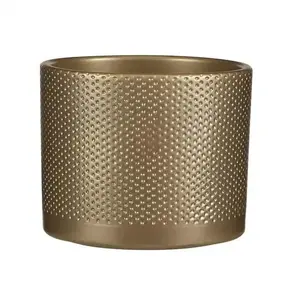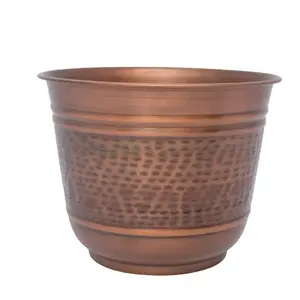(339 products available)






























































































































































































































A cross shape planter is a container for growing plants that has a design resembling a cross. This type of planter can come in various shapes, styles, and materials. They add an extra dimension to gardening and look great in any home. Some of the cross shape planters include:
Wooden cross shape planters
Wooden cross-shaped planters have a classic, warm, and natural look. They are often made from treated wood, like cedar or redwood, which are naturally resistant to rot and pests. Wooden cross planters are usually light and easy to move and come in different sizes and designs.
Ceramic cross shape planters
Cross-shaped planters made of ceramic offer a classy and stylish choice for indoor and outdoor use. They are usually glazed to create a smooth finish and come in different colors and patterns. Ceramic cross planters are heavy, so they are stable and less likely to tip over in the wind. They also keep moisture well, which benefits plants that prefer constant humidity.
Metal cross shape planters
These planters are made of metals like stainless steel, aluminum, or wrought iron. They give a modern look and are very durable. Metal cross planters won't break or be damaged easily, and they can withstand harsh weather. However, they can get hot in the sun, so monitoring soil temperature and providing shade for heat-sensitive plants is essential.
Concrete cross shape planters
Concrete cross planters are sturdy and last long, making them excellent for permanent or semi-permanent garden features. They are usually large and need little maintenance, and their weight keeps them stable in windy conditions. Concrete can be stained or painted to match any desired look.
Fiberglass cross shape planters
Fiberglass cross planters are durable and lightweight. They can be made to look like other materials, such as stone or wood, and are usually UV-resistant and weatherproof. Fiberglass is a good insulator, protecting the plant's roots from temperature changes.
Plastic cross shape planters
Plastic cross planters are affordable and light, making them suitable for indoor and outdoor use. They are often recycled and come in various colors and shapes. Although plastic may not have the same aesthetic appeal as other materials, it is durable and can withstand impacts well.
Glass cross shape planters
These planters are designed using a glass material. They have a modern and elegant look, adding sophistication to any space. Glass cross planters are usually transparent or semi-transparent, showcasing the plants and their roots. They are often used indoors, where they can be admired and handled carefully.
The design of the cross-shaped planters is unique. It offers both aesthetic appeal and practical advantages for urban gardening.
Design style
Cross-shaped planters have a unique and stylish design. They add visual interest to gardens and patios. The cross shape allows for creative planting. It lets users arrange plants in a cross-like pattern. This design is versatile. It fits modern and traditional gardens.
Material options
Cross planters use different materials. Wood is a common choice. It gives a natural look. Wooden planters are often treated to resist weather. Metal planters are strong and have a sleek appearance. They can be rust-resistant. It is suitable for outdoor use. Concrete planters are permanent and sturdy. They can create an industrial feel. Plastic cross-shaped planters are light and affordable. They come in many colors.
Color options
Color options for cross-shaped planters depend on the material. Wooden planters may be stained or painted. Metal planters can have finishes like powder coating. Concrete planters can be painted or stained. Plastic planters come in many colors.
Texture and finishes
Each material has unique textures and finish options. Wood can be smooth or rough. Metal has polished to matte finishes. Concrete can be textured or smooth. Plastic has a smooth finish.
Shape and size
Cross-shaped planters come in many sizes. They fit different spaces and plants. Small ones are good for balconies. Large ones can be used in public gardens. They often have multiple planting sections. It allows for diverse plant selection.
Functionality
The cross shape provides multiple planting areas. It makes cross-shaped planters suitable for small places. It allows for vertical gardening. The design often includes drainage holes. They prevent waterlogging. Some have built-in irrigation systems for easy watering.
Cross-shaped planters are useful for growing plants in many spaces. They are space-saving and stylish, so they are suitable for various settings.
Cross planters are flexible and fit many situations. They grow plants and improve the look and use of indoor and outdoor places. These planters are good for many situations, from homes to cities.
From the material of the cross shape planters to their size and intended use, there are many things to consider when choosing the right one. Some of these considerations are:
Material
Cross-shaped planters are made from different materials, each having its pros and cons. Wooden cross shape planters give a natural and warm look, but they need regular maintenance to prevent rot and warping due to weather changes. Metal planters, like those made from stainless steel or galvanized, are durable and rust-resistant; however, they may heat up the soil more than other options. Ceramic and terracotta planters offer great aesthetic appeal and retain moisture well, but they are more fragile and may require drainage. Moreover, composite materials are lightweight and durable, requiring minimal maintenance.
Size and depth
The size and depth of the cross shape planters should be considered before purchase. The planter's size should correspond to the available space, whether it is an indoor or outdoor area. Moreover, enough root space is required for healthy plant growth, so the planter should be deep enough. Also, this is especially important for plants with extensive root systems.
Drainage
Good drainage is necessary for the health of plants. Cross-shaped planters should have drainage holes to prevent waterlogging, which can lead to root rot. Some planters also have built-in drainage systems, so water does not accumulate at the bottom.
Style and aesthetics
The cross-shaped planter's style and look should go along with the surrounding decor and personal preferences. Different designs, colors, and finishes are available to complement any space, whether modern, traditional, or eclectic.
Mobility and weight
The weight and mobility of cross shape planters should be considered, especially for those who want to move them around frequently or change their outdoor arrangements. Lightweight materials or planters with wheels make it easier to shift from one place to another.
Maintenance
The maintenance requirements of cross-shaped planters vary depending on the material and design. Wooden planters may need periodic sealing and staining, while metal ones should be cleaned to prevent patina. Ceramic planters may require gentle handling when cleaning, whereas composite materials are generally low in maintenance.
Q1: What are the benefits of using a cross-shaped planter?
A1: Cross-shaped planters maximize space utilization, promote vertical growth, and create visually appealing arrangements.
Q2: What materials are commonly used for cross shape planters?
A2: Wood, metal, concrete, and ceramic are popular materials for cross-shaped planters.
Q3: Can cross-shaped planters be used indoors?
A3: Yes, cross-shaped planters can enhance indoor spaces by adding a vertical garden or decorative plant display.
Q4: What plants work well in cross-shaped planters?
A4: Climbing plants, cascading herbs, and certain vegetables like strawberries or greens suit cross-shaped designs.
Q5: How do I maintain a cross-shaped planter?
A5: Regular watering, pruning, and checking for pests are essential; wooden planters may need occasional sealing or staining, while metals should be rust-proofed.